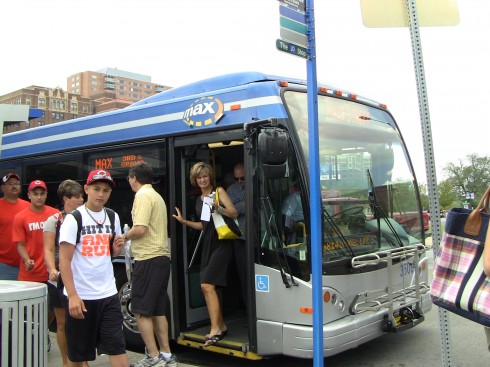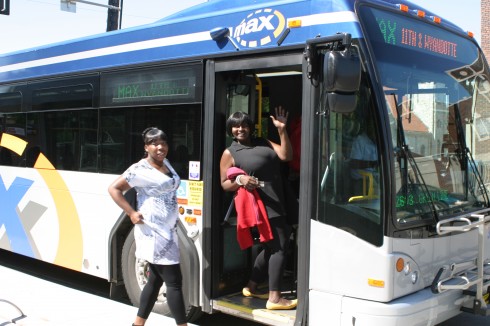Congress Makes Public Transit Commute Benefit Equal To Parking Benefit
(Kansas City, Mo. – Jan. 31, 2012) The Kansas City Area Transportation Authority (KCATA) and the American Public Transportation Association (APTA) laud Congress’ recent approval of the public transit commuter benefit. “This measure removes the financial bias against public transit commuters,” said KCATA General Manager Mark Huffer. “This has always been an issue of fairness, and public transit advocates are pleased that the federal tax code will again provide transit riders with the same tax benefits as those who drive to work.” Under the new “fiscal cliff” legislation passed by Congress this month, the parity between public transit and parking benefits are now up to $240 a month and are retroactive from Jan. 1, 2012. This includes monthly passes purchased through the Transit Riders’ Incentive Plan (TRIP). TRIP allows employers to provide discounted monthly passes to employees on a pre-tax basis. The company reduces its payroll tax, and employees enjoy the pre-tax savings. To learn more about TRIP, companies can call KCATA at (816) 346-0274 or email .(JavaScript must be enabled to view this email address). “On behalf of the millions of Americans who ride public transportation, I commend Congress for passing legislation to increase the public transit commuter benefit, and making it equal to the parking benefit. With parity between public transit and parking benefits, people have the ability to make the best reasonable transportation choice,” said APTA President and CEO Michael Melaniphy. This will expire on Dec. 31, 2013. APTA urged Congress to permanently extend the transit commuter tax benefit to the same level as the parking tax benefit. “It is our hope that in the new Congress, legislation will pass to make the public transit commuter benefit parity permanent,” said Melaniphy. The bill also extends through 2013, the alternative fuels tax credit refund that many public transit systems utilize to offset costs associated with using natural gas and other alternatively fueled vehicles.
Jan. 23: Hickman Mills Transit Center Open House
KCATA Open House to Review Hickman Mills Transit Center Plans
(Kansas City, Mo. – Jan. 17, 2013) The Kansas City Area Transportation Authority (KCATA) will hold an Open House on Jan. 23 to discuss the Hickman Mills Transit Center that is proposed for Bannister Rd. & Blue Ridge Blvd. The meeting will be held Wednesday, Jan. 23, 4 – 6 p.m., at the Three-Trails Village Community Improvement District, 5912 E. Bannister Rd. in Kansas City, Mo. KCATA will present plans for a new transit center that would allow for connections between Troost MAX Green Line, 28-Blue Ridge, 28X-Blue Ridge Express, 175-75th Street, 253-Raytown MetroFlex, and 296-Bannister/Hillcrest MetroFlex. The proposed facility at the southeast corner of Bannister Rd. & Blue Ridge Blvd. would include real-time arrival information, shelters and bike racks. Parking and a customer drop-off area will also be available. Improvements to the area will include ADA accessible boarding platforms, landscaping, ample lighting, wider sidewalks and crosswalks. Metro customers are encouraged to attend the meeting to hear more about how the center will make transit connections more convenient. KCATA is asking for feedback about the proposed transit center. Funding for this transit center will be provided by the federal grant for Troost MAX Green Line. Construction would begin in 2013 and estimated completion would occur in the fall of 2014. The meeting site is served by routes 28 and 296, and the nearby Bannister & Drury Park-and-Ride is served by Troost MAX, 28,175, 253, 296 and 471. To plan a trip on The Metro, customers can call the Regional Call Center at (816) 221-0660 from 6 a.m. to 7 p.m. on weekdays. To arrange a trip on MetroFlex, call 816-346-0346 at least 24 hours in advance. Customers who are unable to attend a public forum can also submit comments on the proposed changes through:- Mail: KCATA, Planning Dept., 1200 E. 18th St., Kansas City, MO 64108
- Phone: 816-346-0300 (leave comment on prerecorded line)
- Email: .(JavaScript must be enabled to view this email address)
Drawings and more information
Site Plan (Focused on shelters sidewalk improvements) [PDF] Site Plan (Entire site) [PDF] View from street (Before and After) [PDF] Rendering of MetroCenter [PDF]Metro Ridership Keeps Growing With Record Bus Ridership in 2012
(Kansas City, Mo. – January 15, 2012) The Kansas City Area Transportation Authority (KCATA) has announced that 2012 Metro ridership exceeded 16.1 million trips, the second highest annual ridership in nearly two decades. Ridership last year was up 3.6% over 2011, representing a 9.5% increase over the last two years. “Kansas City is seeing a growing tide of transit ridership,” said KCATA General Manager Mark Huffer. “The community’s appetite for more transportation options is helping to drive dialogue about how transit should evolve and grow in the region.” In 2012, KCATA began implementing a comprehensive package of budget-neutral changes to make the system more user-friendly and efficient. Main St. MAX, Troost MAX and most Metro routes south of the Missouri River in Kansas City, Mo., were changed in 2012. KCATA will make the final changes, affecting routes in the Northland, in the spring and summer of 2013. The changes are the result of a Comprehensive Service Analysis, or CSA, which examined all bus routes in Kansas City, Mo. In addition to service improvements, other factors have boosted ridership. As the economy recovers, more people in Kansas City were riding transit to get to work. The number of people riding The Metro to seek jobs has gone down, while the number of people riding The Metro to work has risen. Spring 2012 marked the end of the first full academic year that students could use their valid UMKC student ID to ride Metro service. UMKC students were making more than 1,000 trips every weekday. The majority of these were on the Troost MAX Green Line and the Main St. MAX Orange Line. Another factor raising ridership levels was the volatile gas prices throughout the year. While gas prices have dropped for now, they peaked at $3.93/gallon in April and averaged $3.60 for the year. (Source: AAA) The Metro hosted several How-To-Ride Clinics during the spring to educate new riders. Prospective customers learned how to plan a trip, how to pay a fare or use a pass, and how to get on and off a bus. People also learned about online tools, such as Google Trip Planner and WebWatch, a real-time bus tracker. People who want to join the growing ranks of Metro riders can visit [url=http://www.kcata.org]http://www.kcata.org[/url], or call the Regional Call Center at (816) 221-0660. The center’s hours are 6 a.m. to 7 p.m. weekdays.

